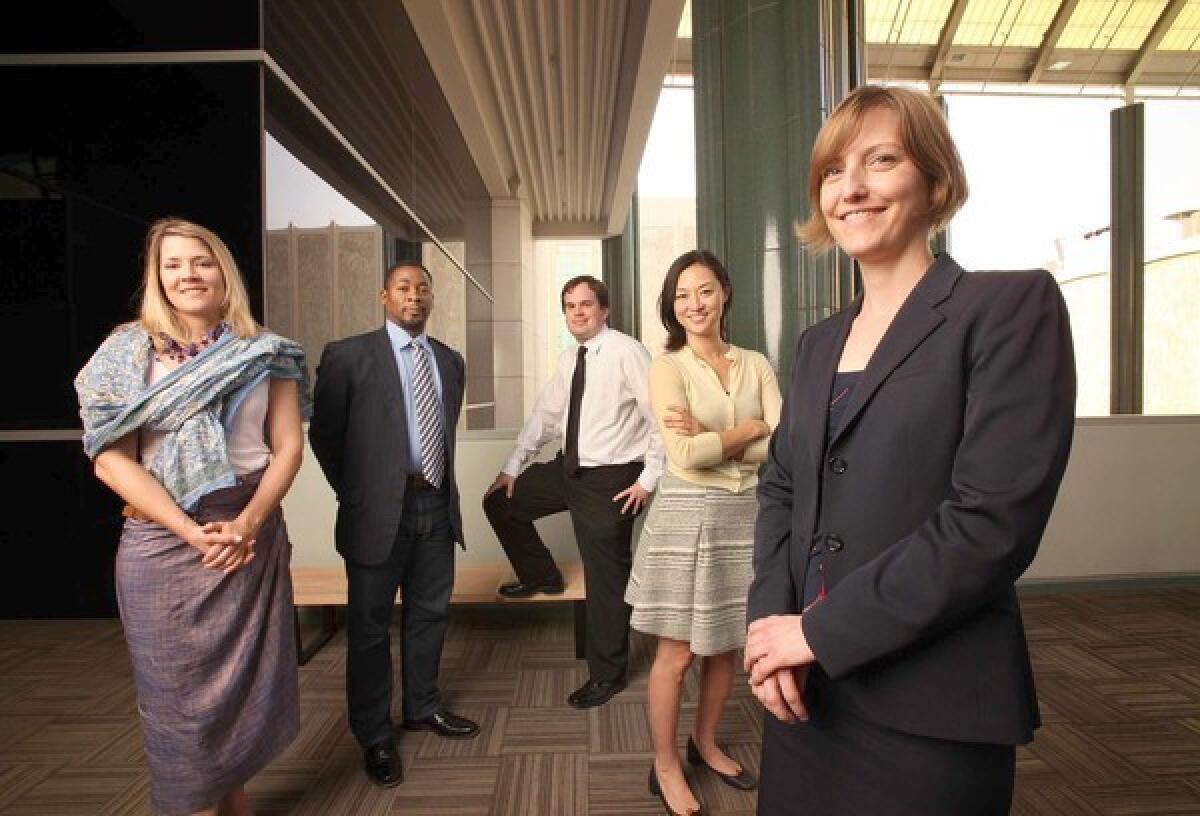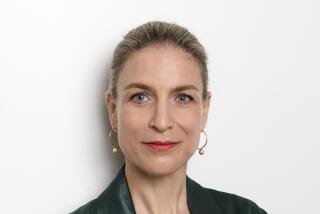New faces on Southland art museum scene

Franklin Sirmans occupies a conspicuously neat space in a complex of glass-front offices at the Los Angeles County Museum of Art. The new head of LACMA’s contemporary art department arrived in January with plenty of ideas, but it takes time to pile up the mountains of books and files that overwhelm many of his colleagues. ¶ Around the corner, Christine Y. Kim has settled in, but just barely. She joined the museum’s staff last September as associate curator of contemporary art. And down the hall, another notably uncluttered office belongs to Britt Salvesen, who came aboard in October as chief of two departments: photography, and prints and drawings. ¶ LACMA’s newest curators have landed in prestigious positions at a high-profile institution where their work will be closely watched. And they are not alone: Amid an economic downturn that has brought cutbacks at museums nationwide, an infusion of new curatorial blood at Southern California museums reflects a growing ethnic diversity as well as fresh perspectives and programmatic growth. ¶ “ Los Angeles still feels like a meritocracy,” Kim says. “You’ve got a crazy idea? I’ve got five minutes.” A Korean American who was born in Newport Beach, raised in the Bay Area and educated on the East Coast, she did curatorial work at the Studio Museum in Harlem before returning to the West Coast and co-founding, with Shamim M. Momin, Los Angeles Nomadic Division, a freewheeling nonprofit group that supports public art projects. In her new job Kim is gaining experience at a relatively traditional institution where she’s developing a big show of time-based media, including film, television, video and Facebook.
FOR THE RECORD:
New curators: An article last Sunday about new curators at Southern California museums said Harold B. Nelson has facilitated the bequest of a 300-piece collection of 19th century American decorative arts at the Huntington Library, Art Collections and Botanical Gardens. The collection includes 19th century pieces, but its strength is in 18th century objects. Also, the article said that Sarah Bancroft was filling the position at the Orange County Museum of Art formerly held by Deputy Director Karen Moss. Moss is still at the museum and curating several exhibitions. —
Whether the new curators work with the latest creations from artists’ studios, 19th century American furnishings or indigenous arts of Africa and the Caribbean, they have chosen a time-honored profession. Unlike colleagues in academia, art museum curators use their training in art history to engage with objects, artists and the public. With the support of sympathetic directors, they can have a big impact as they shape collections, cultivate donors, organize exhibitions and write catalog essays.
Southern California’s recent arrivals don’t fit a mold. From their 30s to their 60s, they come from near and far. Some wear jeans or flannels; others have a flair for affordable chic. No one gets rich on a standard curator’s salary. But there are perks: travel, close encounters with extraordinary art, professional and social connections, opportunities to explore ideas in exhibitions and publications.
Despite obvious challenges, the curators say, this is an exciting time to be in and around Los Angeles. In LACMA’s contemporary art department, Sirmans, an African American, is working with Kim and Rita Gonzalez, who has extensive experience in Latin American art. At the Museum of Contemporary Art San Diego, associate curator Lucia Sanroman, a native of Mexico, lives in Tijuana and forges relationships with Mexico’s art community.
Diverse staffs
Over the last couple of years, about 20 curators have started or accepted jobs at Southern California’s art museums. And the number may rise after Jeffrey Deitch soon takes charge of the Museum of Contemporary Art.
Within the last 10 months, the Huntington Library, Art Collections, and Botanical Gardens has appointed Harold B. Nelson its first curator of decorative arts and the Museum of Latin American Art in Long Beach has hired Cecilia Fajardo-Hill as chief curator. The Hammer Museum has installed Douglas Fogle as chief curator and Anne Ellegood as senior curator. The Fowler Museum at UCLA has welcomed Patrick Polk as its first curator of Caribbean and Latin American Popular Arts and announced the appointment of Gemma Rodrigues, who will arrive in July as curator of African arts.
Whether filling vacancies or new positions, the curators say they were attracted by inspiring directors, opportunities to develop programs and collections and the cultural riches of the region.
Fajardo-Hill, a scholar of Latin American art who has directed a contemporary art space in Caracas, Venezuela, and the Cisneros Fontanals Arts Foundation in Miami, answered the plea of Richard P. Townsend, the new president of the Museum of Latin American Art, to help him transform the institution founded by the late Robert Gumbiner. “I was thinking of going to England to do something more calm,” she says. “But there is only one museum of Latin American art in the States, and it’s this one. Everything is in place to do something great, so I had no excuse to say no.”
Rodrigues, a native of Zimbabwe who established a lively contemporary art program there and is finishing her doctoral dissertation at Harvard before joining the Fowler, views her new home as a multicultural hotbed of creativity. “I have this strong feeling, from the vantage of Boston, that Los Angeles is open to experimenting and rethinking the relationship between art and viewer and consumer and the museum culture,” she says. “It recalls the depth of excitement that pervaded Zimbabwe and South Africa just after they became independent.”
New direction
Some of the curatorial movement is simply a changing of the guard. Sirmans succeeded Lynn Zelevansky, who left LACMA to direct the Carnegie Museum of Art in Pittsburgh. Salvesen, whose position reflects a departmental reconfiguration, took charge of the photography territory built by the late Robert Sobieszek and briefly managed by Charlotte Cotton. In prints and drawings, Salvesen followed Kevin Salatino, now director of the Bowdoin College Museum of Art in Brunswick, Maine.
At the Hammer, Fogle filled the void left by Gary Garrels, who took a position at the San Francisco Museum of Modern Art. Ellegood took charge of the Hammer Projects series formerly overseen by James Elaine, now an adjunct curator who spends much of his time in China. At the Orange County Museum of Art, Sarah Bancroft -- who is working on the 2010 California Biennial and a Richard Diebenkorn show -- moved into the position formerly occupied by Deputy Director Karen Moss.
Other curatorial shifts are the result of promotions or a sort of cross-town musical chairs. The J. Paul Getty Museum moved long-time curator Judith Keller into the top spot in its department of photographs. Catherine Hess, former curator of sculpture and decorative arts at the Getty, is now chief curator of European art at the Huntington, where she hopes to help visitors better understand the recently renovated historic house and fill gaps in the collection.
The changes also indicate new directions. The Autry National Center’s new associate curator of film and popular culture, Jeffrey Richardson, is steadily updating the museum’s permanent collection galleries “so that they appeal to 10-year-olds as well as 70-year-olds,” as he puts it.
At the Huntington, which has collected American art for a mere 30 years and only recently gained a significant showcase for it, a department of one, curator Jessica Todd Smith, has expanded to three. Nelson, former director of the Long Beach Museum of Art, has facilitated the bequest of a 300-piece collection of 19th century American furniture, ceramics, needlework, metal and glass amassed by Victor Gail and the late Thomas H. Oxford. Associate curator Kevin Murphy is planning a series of exhibitions from the Huntington’s American holdings and co-organizing a loan show, “Taxing Visions: Financial Episodes in Late 19th-Century American Art.”
As is often the case in Los Angeles, there’s a Getty factor on the curatorial front. Several relatively new curators are working on “Pacific Standard Time: Art in L.A 1945-1980,” a Getty-sparked collaborative effort that will bring a bonanza of exhibitions to Southern California this fall. The Getty Foundation has given more than $6.7 million in grants for research, planning and implementation of the exhibitions, enabling some of the museums to augment their curatorial staffs.
San Diego’s Museum of Contemporary Art hired Robin Clark to help organize “Phenomenal: California Light and Space,” along with other projects. With the help of Getty money, Nelson is working on a major show of Sam Maloof’s furniture at the Huntington. The Norton Simon Museum in Pasadena didn’t apply for a Getty grant, but Leah Lehmbeck, the Simon’s newest curator, is exploring the role of printmaking in Southern California for a “Pacific Standard Time” show.
All the recent arrivals have their work cut out for them. The biggest challenge, they say, is the sheer size and complexity of the art community. For contemporary art curators, the Hammer’s Anne Ellegood says, “the fundamental thing that makes Los Angeles so interesting is the number of interesting artists who are here. It can be a little overwhelming, but it’s really inspiring.”
More to Read
The biggest entertainment stories
Get our big stories about Hollywood, film, television, music, arts, culture and more right in your inbox as soon as they publish.
You may occasionally receive promotional content from the Los Angeles Times.










